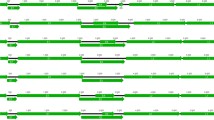Abstract
The genome of the European elk papillomavirus (EEPV) was found to be 8,095 base pairs (bp) long and its genetic organization was similar to that of other papillomaviruses. Ten open reading frames (ORFs), designated E1-E7 and L1-L3, were identified in the genome, all located on one strand. The presence of the L3 ORF is rare among the papillomaviruses and to date has only been identified in the genomes of EEPV, the deer papillomavirus (DPV) and the Cottontail papillomavirus (CRPV). The ORF is well conserved beteeen DPV and EEPV with regard to both length and sequence. Potential promoter regions were identified at the 5′-end of the E6 ORF, at the 3′-end of the E1 ORF and downstream of the L1 ORF. Furthermore, two potential polyadenylation signals were found, one located in the long control region (LCR), downstream of the L1 ORF, and another preceding the L2 ORF. The EEVP genome is closely related to the genome of the DPV, the most highly conserved regions being ORFs E1 (70%), E5 (69%), and L1 (74%).
Similar content being viewed by others
References
Pfister H. Biology and biochemistry of papillomaviruses, Rev Physiol Biochem Pharmacol,99:111–181, 1984.
Stenlund A., Moreno-Lopez J., Ahola H., & Pettersson U. European elk papillomavirus; characterization of the genome, induction of tumors in animals, and transformation in vitro, J Virol48:370–376, 1983.
Groff D.E., Sundberg J.P., & Lancaster W.D. Extrachromosomal deer fibromavirus DNA in deer fibromas and virus-transformed mouse cells, Virology131:546–550, 1983.
Moreno-Lopez J., Ahola H., Eriksson A., Bergman P., & Pettersson U. Reindeer papillomavirus transforming properties correlate with a highly conserved E5 region, J Virol61:3394–3400, 1987.
Olson C., Gordon D.E., Robl M.G., & Lee K.P. Oncogenicity of bovine papillomavirus, Arch Environ Health19:827–837, 1969.
Koller L.D., & Olson C. Attempted transmission of warts from man, cattle, and horses and of deer fibroma, to selected hosts. J Invest Dermatol58:366–368, 1972.
Dvoretzky I., Shober R., Chattopadhyay S.K., & Lowy D.R. A quantitative in vitro focus assay for bovine papilloma virus. Virology103:369–375, 1980.
Friedman J.C., Levy J.P., Lasneret J., Thomas M., Boiron M., & Bernard J. Induction de fibromes sous-cutanes chez le hamster dore par inoculation dextraits acellularies de papillomes bovins. C R Acad Sci, Paris,257:2328–2331, 1963.
Moreno-Lopez J., Mörner T., Pettersson U. Papillomavirus DNA associated with pulmonary fibromatosis in European elk, J Virol57:1173–1176, 1986.
Ahola H., Bergman P., Ström A.C., Moreno-Lopez J., & Pettersson U. Organization and expression of the transforming region from the European elk papillomavirus (EEPV), Gene50:195–205, 1986.
Chen E.Y., Howley P.M., Levinson A.D. & Seeburg P.H. The primary structure and genetic organization of the bovine papillomavirus type 1 genome, Nature299:529–534, 1982.
Ahola H., Stenlund A., Moreno-Lopez J., & Pettersson U. Sequences of bovine papillomavirus type 1 DNA—functional and evolutionary implications, Nucl Acid Res11:2639–2650, 1983.
Potter H.L.Jr., & Meinke W.J. Nucleotide sequence of bovine papillomavirus type 2 late region, J Gen Virol66:187–193, 1985.
Groff D.E., & Lancaster W.D. Molecular cloning and nucleotide sequence of deer papillomavirus, J Virol56:85–91, 1985.
Schwartz A., Durst M., Demankowski C., Lattermann O., Zech R., Wolfsperger E., Suhai S., & zur Hausen H. DNA sequence and genome organization of genital human papillomavirus type 6b, EMBO J2:2341–2348, 1983.
Seedorf K., Krämmer G., Durst M., Suhai S., & Röwekamp W.G. Human papillomavirus type 16 DNA sequence, Virology145:181–185, 1985.
Maxam A., & Gilbert W. Sequencing end-labeled DNA with base-specific chemical cleavage, Methods enzymol65:499–560, 1980.
Devereux J., Haeberli P., & Smithies O. A comprehensive set of sequence analysis programs for the VAX. Nucl Acids Res12:387–395, 1984.
Giri I., Danos O., Yaniv M. Genomic structure of the cottontail rabbit (Shope) papillomavirus. Proc Natl. Acad Sci USA82:1580–1584, 1985.
Pilacinski W.P., Glassman D.L., Krzyzek A., Sadowski P.L., & Robbins A.K. Cloning and expression in Escherichia Coli of the bovine papillomavirus L1 and L2 open reading frames. Biotechnology1:356–360, 1984.
Baker C.C., & Howley P.M. Differential promoter utilization by the bovine papillomavirus in transformed cells and productively infected wart tissues, EMBO J6:1027–1035, 1987.
Stenlund A., Bream G.L., & Botchan M.R. A promoter with an internal regulatory domain is part of the origin of replication in BPV-1. Science236:1666–1671, 1987.
Brady J., Radonovich M., Vodkin M., Natarajan V., Thoren M., Das G., Janik J., & Salzman P. Sitespecific base substitution and deletion mutations that enhance or suppress transcription of the SV40 major late RNA. Cell31:625–633, 1982.
Brady J., Radonovich M., Thoren M., Das G., & Salzman N.P. Simian virus 40 major late promoter: an upstream DNA sequence required for efficient in vitro transcription, Mol Cell Biol4:133–141, 1984.
Spalholz B., Lambert P.F., Yee C.L., & Howley P.M. Bovine papillomavirus transcriptional regulation: localization of the E2-responsive elements of the long control region, J Virol61:2128–2137, 1987.
Moskaluk C., & Bastia D. The E2 “gene” of bovine papillomavirus encodes an enhancer-binding protein, Proc Natl Acad Sci USA84:1215–1218, 1987.
Danos O., Kantish M., & Yaniv M. Human papillomavirus la complete DNA sequence: a novel type of genomeorganization among papovaviridae, EMBO J1:231–236, 1982.
Zachow K.R., R.S., & Faras A.J. Nucleotide sequence and genome organization of human papillomavirus type 5, Virology158:251–254, 1987.
Fuchs P.G., Ianer T., Weninger J., & Pfister H. Epidermodysplasia verruciformis-associated human papillomavirus 8: genomic sequence and comparative analysis, J Virol58:626–634, 1986.
Dartmann K., Schwartz E., Gissman L., & zur Hausen H. The nucleotide sequence and genome organization of human papilomavirus type 11, Virology151:124–130, 1986.
Cole S.T. & Danos O. Nucleotide sequence and comparative analysis of the human papillomavirus type 18 genome, J Mol Biol193:599–608, 1986.
Cole S.T., & Streeck R.E. Genome organization and nucleotide sequnce of human papillomavirus type 33, which is associated with cervical cancer, J Virol58:991–995, 1996.
Author information
Authors and Affiliations
Rights and permissions
About this article
Cite this article
Eriksson, A., Ahola, H., Pettersson, U. et al. Genome of the European elk papillomavirus (EEPV). Virus Genes 1, 123–133 (1988). https://doi.org/10.1007/BF00555932
Issue Date:
DOI: https://doi.org/10.1007/BF00555932




